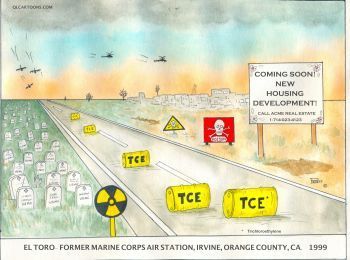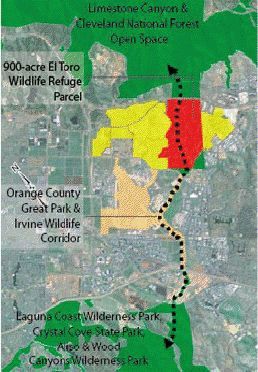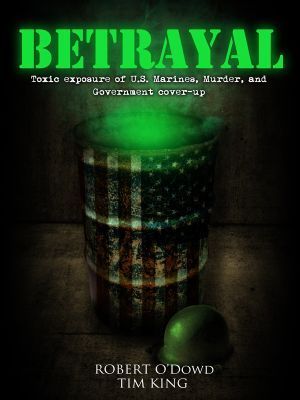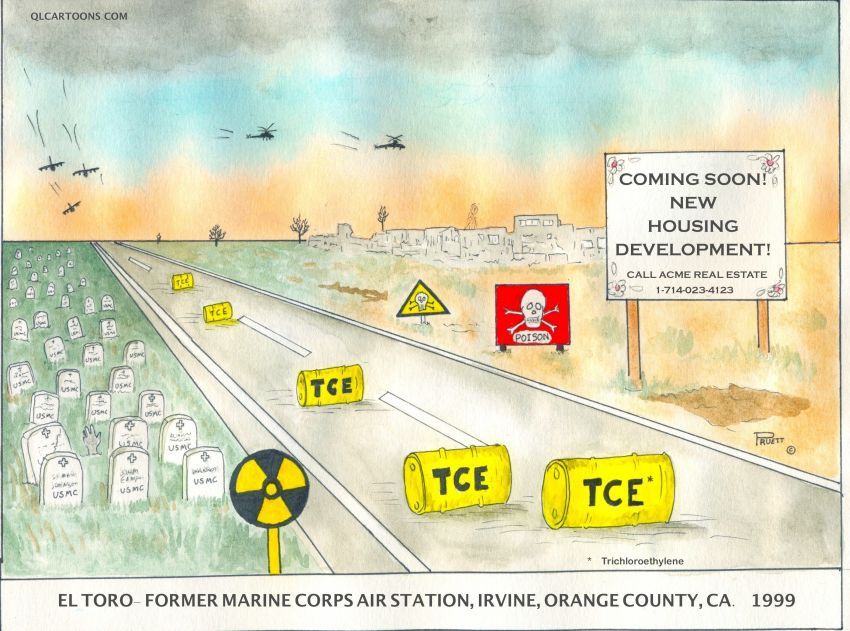
Publisher:
Bonnie King
CONTACT:
Newsroom@Salem-news.com
Advertising:
Adsales@Salem-news.com

~Truth~
~Justice~
~Peace~
TJP
Nov-12-2012 20:29

 TweetFollow @OregonNews
TweetFollow @OregonNews
Dioxin, TCE Drums, U-235 and El Toro's Panhandle
Robert O'Dowd Salem-News.comWhat lurks beneath this old Marine base?
 Original artwork for Salem-News.com, by Shelli Pruett, author of Quantum Leap Cartoons, featured at www.QLCartoons.com |
(IRVINE, CA) - The Navy will label this fiction but if you wanted to hide environmental contamination and avoid expensive remediation from weapons grade U-235, Agent Orange, buried drums of TCE, then the proposed transfer of the 900+ acres of El Toro’s panhandle from the FAA to the FBI makes sense.
The FBI plans to turn El Toro’s panhandle into a training facility “with outdoor shooting ranges, explosions, helicopter landings and impregnable fences,” according to the news story in the Orange County Register on April 2, 2012, “U.S. reneging on land deal for wildlife corridor.”
El Toro’s panhandle may be contaminated with weapons grade U-235, dioxin (the toxic chemical in Agent Orange), and buried, rusting 55 gallon drums of TCE; the government would label this as wild and unfounded speculation.
We do know that one El Toro Marine who never served in Vietnam died from Agent Orange exposure, Dr. Chuck Bennett over 12 years ago cited two Orange County experts who examined soil samples from the panhandle and found weapons grade U-235 (the stuff that makes the BANG in nuclear bombs); and the Navy ignored testimony from an Orange County environmental expert who reported that TCE drums were buried on the base to hide them from the Marine Corps Inspector General. Public Works Department kept no record on the locations of the buried drums, but the base’s panhandle would be the perfect place for a frontend loader to bury the 55 gallon metal drums.

Even Shakespeare’s Marcellus (“Something is rotten in the state of Denmark”) would agree that the agreement to reserve a wildlife corridor in the panhandle by the federal government made years ago and then reneged on this year has a rancid smell to it.
In 2001, the Navy turned over stewardship of the 900+ acres of the El Toro panhandle to the Federal Aviation Administration (FAA). According to the April 2nd Orange County Register news story, the FAA said “it no longer is able to manage the land.” If the FAA can’t manage the property, then why not turn over the property to Orange County or the City of Irvine? One good reason is that the FAA would be liable for remediating contamination on the property with the exception of two contaminated sites on this acreage under the Navy’s remediation responsibility.
Part of the agreement between the federal government and Orange Count in 2001 was that a federal habitat reserve, the El Toro National Wildlife Refuge, would be established and no new development would be allowed on the property. The proposed reserve would be home to the highest regional concentrations of the threatened coastal California gnatcatcher and coastal cactus wren.
Many of us who were El Toro Marines remember the base’s magazine bunkers were located in the panhandle. The rife range in the 1960s didn’t meet Marine Corps standards since it only included firing position at 200 and 300 yards, not the 500 yards prone position required for rife qualifications. In the 1960s, El Toro Marines went to Camp Pendleton every other year for rifle qualification and used the El Toro range in the off year for practice. The panhandle is a high risk wildfire area and the location of the base’s magazine bunkers and the threat of wildfires were real.
Fires and explosives do not make a good marriage. If wildfires had reached the magazine bunkers while El Toro was an active military base, the inevitable explosion would have been catastrophic. In 2007, the Santiago Canyon wildfire burned most of the panhandle. If this happened when MCAS El Toro was an active base, the ensuing explosions would have been heard in San Diego.
AGENT ORANGE AT EL TORO?

In the 1960s, the toxic effects of exposure to Agent Orange were not widely known outside of scientific circles. This herbicide would more been seen as an effective means of reducing the threat of wildfires in El Toro’s panhandle. The facts are that Agent Orange was used at El Toro and at least one Marine died from exposure to Agent Orange at the base.
Agent Orange, a 50:50 mixture of 2,4-D and 2,4,5-T, was used by the military in Vietnam from 1961 until 1971 to defoliate forested and rural land, depriving the Vietcong of cover and food supply. Manufactured for the Defense Department by Dow Chemical, Monsanto and others, Agent Orange was discovered to be contaminated with 2,3,7,8-tetrachlorodibenzodioxin (TCDD), an extremely toxic dioxin compound. The Center for Disease Control reported TCDD as one of the most toxic chemicals known to man.
Dioxin is not found in nature; this is a manmade toxic chemical. The dioxin family includes 75 chemicals; the most toxic is 2,3,7,8 TCDD and contaminated the Agent Orange used in Vietnam. Dioxins are also produced by the combustion of wood and chlorine, and by fires involving chlorinated benzenes and biphenyls (e.g. PCBs). El Toro had 4 landfills and burning was used to reduce volume in the landfills; 2 crash crew and fire fighting burn pits were in use, too. Incomplete combustion from the landfill burnings and crash crew burn pits could results in dioxin.
In fact, dioxin was reported at two of El Toro’s contaminated sites: Site 1, Explosive Ordnance Disposal Range, in the panhandle and Site 9, Crash Crew and Fire Burning Pit, in the southwest quadrant of the base.
The El Toro Marine veteran who transported materials to the base’s landfills died in 2008 from CLL, a form of non-Hodgkin's lymphoma, from exposure to Agent Orange and benzene. This is not speculation; it’s the official opinion of VA medical professionals and the VA Board of Veterans’ Appeals.
This Marine was an Air Freight Operations Man at El Toro from February 1967 to May 1967 and from July 1969 to October 1970. The BVA found that, “the veteran was noted to have been exposed to air pollution generated from the burnings at the four landfills during his service in the October 2009 opinion. Benzene, alkalating agents, aromatic amines, solvents used in chemicals, plastic, rubber, exposure to petroleum products, paint, agricultural chemicals and chemical exposures were known causes of leukemia. It was more likely than not that the veteran's leukemia and lymphoma were caused from this in-service chemical exposure at El Toro MCAS during his transport of hazardous materials and his exposure to pollution from landfill burnings [our emphasis].”
 Available now on Amazon Kindle |
The Marine veteran never saw a penny of the disability compensation he was entitled to. Following his death, his widow was awarded VA compensation (DIC), after a successful appeal to the BVA.
The BVA decision said that the Marine wore a gasmask. This should have been adequate to protect him from inhalation of any dioxins at the base’s landfills. But, if he lifted ‘empty 55 gallon drums’ of Agent Orange for transport to the landfills while not wearing the gasmask or protective gloves, then dermal and inhalation exposure to this herbicide and 2,3,7,8 TCDD could have occurred.
From my experience, you can bet the Marine didn’t wear the gasmask when driving hazardous materials to the landfills. For one, it would have been extremely difficult to drive with the gasmask on and why wear the mask when loading materials on a truck some distance from any landfills?
The BVA said that, “A July 2004 opinion from Dr. D. K. noted that he had been
treating the Veteran for CLL, a form of non-Hodgkin's lymphoma. The physician opined that this cancer was related to the Veteran's exposure to Benzene and to Agent Orange. An April 2008 opinion from Dr. D. K. noted that the Veteran's prognosis was extremely poor and that he was considered terminal. The physician opined that his CLL is most likely than not due to his Agent Orange exposure [our emphasis].”
Could this man’s death have been the result of dermal and inhalation exposure to dioxin from ‘empty Agent Orange drums’ transported to the landfills? There’s no record that the dead Marine wore protective gloves, leaving him open to Agent Orange exposure from dermal contact and possibly inhalation exposure of AO vapors while handling the drums.
In a ‘Catch 22’ response, the VA denied our FOIA request for supporting documentation on the veteran’s death, citing the need to obtain the approval of the widow. There was no way for us to contact his widow since the BVA decision redacted the veteran’s name. This wasn’t the proverbial ‘no ticket; not shirt’ but you get the idea.
A high risk area from wildfires covers the 900+ acres in El Toro’s panhandle. In 2001, the panhandle was transferred to the FAA and not included in the GSA public auction sale of the base in 2005. Without soil and groundwater samples near the former magazine bunkers and other areas, there’s no way to know the extent of Agent Orange contamination. But, given the risk of wildfires, catastrophic explosions and Agent Orange’ effectiveness in reducing vegetation growth, there’s no question that Marines with access to this herbicide in the 1960s/1970s could have made good use of it.
A toxicologist told me that dioxin (TCDD) is also a by-product of incomplete combustion which makes those exposed to inhalation of smoke from El Toro’s open burn pits at risk of exposure to this carcinogen. El Toro’s landfills burned solid waste, oil, paint residues, flammable fluids, jet fluid, industrial solvents, aviation gasoline and other liquids into the air.
The use of Agent Orange, an excellent herbicide, to control the growth of vegetation and reduce the risk of wildfires at El Toro makes sense. In 2007, the San Santiago Canyon wildfire burned most of the vegetation in the panhandle.
The BVA opinion noted that exposure to Agent Orange and Benzene at El Toro was the cause of his death:
- An October 2009 opinion from Dr. D. R., one of the Veteran's treating VA physicians, noted that he had died from CLL and small cell lymphoma. During service, the Veteran had been stationed at El Toro a MCAS in California from August 1968 to April 1971 during which time he worked as an air freight man and drove a truck. He wore a gas mask and protective shoes during this time. E1 Toro MCAS was closed in 1999 due to soil and ground contamination. Activities at the base "generated harmful waste and pain residues, hydraulic fluids, batteries and other waste into the soil and grounds from several past operations”. There were also four landfills located on the base which burned solid waste, oil, paint residues, flammable fluids, jet fluid, industrial solvents, aviation gasoline and other liquids into the air… A July 2004 opinion from Dr. D. K. noted that he had been treating the Veteran for CLL, a form of non-Hodgkin's lymphoma. The physician opined that this cancer was related to the veteran's exposure to Benzene and to Agent Orange [our emphasis].
- An April 2008 opinion from Dr. D. K. noted that the Veteran's prognosis was extremely poor and that he was considered terminal. The physician opined that his CLL is most likely than not due to his Agent Orange exposure [our emphasis].
- The veteran underwent chemotherapy in the fall of 2004 and in the fall of 2007. He was admitted for nursing home care in August 2007. Palliative radiation therapy was performed in the spring of 2008 following the development of a small lymphocytic lymphoma. He expired in April 2008.
Dioxin in soil samples from the burn pits and landfills would not be unexpected since according to EPA, “2,3,7,8-Tetrachlorodibenzo-p-
According to the California Department of Toxic Substances Control (DTSC), there’s no evidence from soil samples of elevated dioxin on the base.
ENVIROSTOR
Envirostor, California’s Department of Toxic Substances Control public website provides access to detailed information on hazardous waste and existing site cleanup information for former MCAS El Toro.
DTSC’s Envirostor reports 2,3,7,8 TCDD as a potential contaminant of concern for El Toro.
However, according to Mr. Quang Than, DTSC Project Manager for MCAS El Toro, no TCDD was found at El Toro.
Mr. Than said at El Toro’s Site 9, a crash crew and fire fighting burn pit within MWSG-37, only low levels of a dioxin compound were found: “It [TCDD] was listed as a potential chemical of concern (COC) but did not make the list of (confirmed) COCs because the type of dioxin found at Site 9 has very low concentrations.”
OTHER MARINES TELL OF AGENT ORANGE USE
The use of Agent Orange was reported to Salem-News.com by two Marine veterans of MAG-11 (Marine Air Group-11). These Marines said they sprayed Agent Orange around the fence lines and other areas on the base to control the growth of vegetation.
One of the Marine veterans is a prostate cancer survivor. Prostate cancer is one of the illnesses associated with exposure to dioxin. These men are now attempting to locate other MAG-11 veterans who sprayed dioxin at El Toro.
Another Marine veteran who attended the Nuclear, Biological & Chemical (NBC) Warfare training school at El Toro in the 1960s shared some of his experiences with us via email. They include exposure to Agent Orange and Sarin. These are definitely not the kind of toxins that should be used in a ‘training problem’ without regard to the health effects of those exposed to them.
In fact, Sarin is a chemical nerve agent now seen as a weapon of mass destruction under UN Resolution 687 (April 1991).
Sarin causes the victim to loss control of bodily functions, vomit, defecate and urinate until the individual becomes comatose and suffocates in a series of convulsive spasms.
Today, this Marine suffers from a variety of medical conditions that could be associated with toxic exposures. However, the VA denied service connection to most of his chronic medical conditions. He is now in the process of tracking down other Marines who attended El Toro’s NBC training in an effort to confirm his exposures to toxic chemicals. Any Marine who attended NBC training in the 1960s and is willing to write a VA buddy letter for this Marine can email Salem-News.at newsroom@salem-news.com. At his request, we are withholding his name:
- I just discovered your article pertaining to El Toro Marine Air Base. I was stationed there in 1970 at the Nuclear, Biological & Chemical Warfare training school. During that time we were exposed to a variety of chemicals and hazardous materials. Since we were mostly enlisted, after the “school-work” we were assigned “clean-up activities and “gardening” in the “Vegetable patch”. We were instructed to spray chemicals along the fence lines to kill the weeds and unwanted vegetation. Part of our training was to witness and observe how quickly the chemicals could kill the vegetables in the “patch” [corn, wheat, root vegetables, etc. In addition, part of the training was with gas [possibly Sarin; though they never told us]; we were led into Quonset huts and beyond a partition goats were also led in the other side; they were killed by the gas. We were then instructed to inject atropine into our thighs to counteract the effects of the gas. Before my honorable discharge in 1971, I went through a physical and medical evaluation board and was awarded 10% disability based on losing all of the hearing in my left ear. Once discharged the VA down-graded this to 0% service-connected. I never pursued appealing this for over 40 years. I finally re-opened my claim in 2010; still waiting to hear from the VA. Since that time I have been treated for Diabetes Mellitus, Kidney failure, coronary artery disease [quintile by-pass in 2006], diabetic neuropathy, and a host of other physical ailments.
Still not convinced that Agent Orange wasn’t used on the base? Neither are we.
NUKES AT EL TORO?
Dead men tell no tales, but those who publish their research go on helping people long after they are gone. That is the case with the late Dr. Chuck Bennett, former Chair of the Technical Subcommittee of El Toro’s Restoration Advisory Board wrote a letter to the Fullerton Observer, dated May 29, 2000 entitled "An Update on Critical Issues for the El Toro Base Closure". Dr. Bennett died of a heart attack in December 2000.
Dr. Bennett wrote, "Five decades of military operation have certainly had its impact on the environment at El Toro. Over 400 underground storage tanks that do not meet the 1998 Federal guidelines for storage use must be taken care of, which means either removed or closed in place."
"It will take years to clean up or take care of the messes that the DoN sprinkled over 4500 acres of prime Orange County land. It may be prime land, but it sure isn’t pristine land! The DoN has made it clear that they have no intention of returning pristine land to the County. They will clean up the 4500 acres only to the levels that the Regulatory Agencies require."
A number of topics are discussed in Dr. Bennett's letter. One regards "an important report" from Department of Navy consultants released in 2000, about radionuclides in the groundwater at El Toro near the base’s four landfills and the EOD, or Explosives Ordnance Disposal area.
Consultants concluded at the time, that the only radionuclide of importance present at the site was Uranium of natural origin. Dr. Bennett said that if it is of natural origin the DoN would have no obligation to remediate the Uranium.
"But the DoN has a bit of a problem," Dr. Bennett wrote.
"The Uranium they found in Site 1 has too much Uranium 235 in it (N.B. it is the U-235 in Uranium that makes nuclear power plants work and splits when an atom bomb explodes). The amount of U-235 in the Site 1 samples is more than twice as much as you would find in natural uranium and several outside experts have confirmed that the Site 1 results demonstrate enriched uranium. If it is enriched, it is manmade and not natural. If it is not natural, the DoN will become liable for remediating all the Uranium. If it is shown to be enriched Uranium at the base, don’t bother to ask me how it got there. Ask the DoN."
Enriched Uranium-235 has a half-life of 703 million years. Needless to say it will around for a long time.
So if nuclear waste exists at El Toro, how did it get there? An El Toro Marine, who chose not to be named, served there in the 1950s. He explained:
“The first use of small nuclear weapons (small enough to be on the hard points under a Sky Hawk) was done by the Navy and quite possibly, Marine aviators in the 50s.
The A-4 Sky Hawk was one of the Marine Corps' primary attack jets until they were replaced in the early 1980s by the F/A-18 Hornet.”
The former Marine said, "our squadrons worked out of El Toro and the test or (tests) were actually carried out on the Yucca Flats (or wherever we did the bulk of our ground testing which included even smaller nuclear weapons which could be mounted on 105-155 artillery)." Now, this really gets interesting.
NAVY TOLD OF BURIED TCE DRUMS
Mr. Don Zweifel, Restoration Advisory Board (RAB) member, reported to the Navy way back on July 27, 2005 during public comments on “El Toro’s Draft Record of Decision for Site 24, the Volatile Organic Solvent (VOC) Source Area” that former El Toro employees told him of the practice of burying drums of contaminants on the base.
No records were maintained of where the barrels were buried and the Navy’s official response was no remediation efforts would be undertaken unless the buried barrels were found. Barring a miracle, it’s unlikely that the barrels will spontaneously appear on the ground surface. Over time, the steel 55 gallons drums will rot and the toxic contaminants will be released into the soil.
Although this could be a tedious effort, the military has the means of detecting buried metal containers. Although not suggested by Mr. Zweifel, a search of the 4,000 acres property by the military could locate the buried drums. Once found, the drums could be removed and properly disposed of.
Why wait for the drums to rot and endanger children and others? A proactive remediation approach would avoid injuries from rotting containers spilling their contents into the ground.
Review showed that the Navy ignored Zweifel’s concerns about the need to find the barrels, citing their policy, “The Department of the Navy (DON) also has a comeback policy that states the circumstances under which the DON will return to perform additional cleanup. One of those circumstances is the subsequent discovery of additional contamination attributable to DON activities. This would allow for additional investigation if buried barrels of contaminants where found anywhere on Former MCAS El Toro property in the future.”
A better alternative than to wait for the buried TCE drums to rot and empty their contains into the soil and groundwater would be to extract the buried drums by using similar ground penetrating technology employed by the U.S. Army at Camp Carroll, South Korea.
The U.S. Army and the Korean government are using ground penetrating technology to locate hundred of buried drums of Agent Orange and other chemicals at Camp Carroll in South Korea. The joint task force used a process called “Electrical Resistivity” to locate and map abnormalities underground.
Lee Sun-Young, reporter for The Korea Herald, broke story on July 9, 2011 on the use of ground penetrating technology to locate the buried AO drums. According to Sun-Young, “A joint Korea-US investigation team found signs that metallic objects, shaped like drums, may be buried underground at one of the US military camps in Korea…the will now take samples of soil from as far as 10 meters deep to verify a claim by US veteran Steve House that he helped bury hundreds of drums believed to contain Agent Orange near a helipad in Camp Carroll…geophysical surveys of the helipad area found some anomaly.” The joint task force is co-chaired by OK Gon, professor at Bookyung University and Colonel Joseph F. Birchmeier, U.S. Army.
 Original artwork for Salem-News.com, by Shelli Pruett, LA-based author of Quantum Leap Cartoons, featured at www.QLCartoons.com |
Articles for November 11, 2012 | Articles for November 12, 2012 | Articles for November 13, 2012
Quick Links
DINING
Willamette UniversityGoudy Commons Cafe
Dine on the Queen
Willamette Queen Sternwheeler
MUST SEE SALEM
Oregon Capitol ToursCapitol History Gateway
Willamette River Ride
Willamette Queen Sternwheeler
Historic Home Tours:
Deepwood Museum
The Bush House
Gaiety Hollow Garden
AUCTIONS - APPRAISALS
Auction Masters & AppraisalsCONSTRUCTION SERVICES
Roofing and ContractingSheridan, Ore.
ONLINE SHOPPING
Special Occasion DressesAdvertise with Salem-News
Contact:AdSales@Salem-News.com

googlec507860f6901db00.html



Terms of Service | Privacy Policy
All comments and messages are approved by people and self promotional links or unacceptable comments are denied.
Robert Silvas September 15, 2017 7:57 am (Pacific time)
Wel Done
Frank Vera November 13, 2012 9:22 am (Pacific time)
The DOD did an inter-agency transfer at: 1) The United States Penitentiary (USP) in Atwater, CA was built on Castle Air Force Base’s Weapons Storage Areas (WSA) 2) The Victorville Federal Correctional Complex (FCC), CA was built on George Air Force Base’s Weapons Storage Areas (WSA). The significance of the WSA is explained in the USAF report “Buried Radioactive Weapons Maintenance Waste” http://www.georgeafb.info/reference/documents/buried-radioactive-weapons-maintenance-waste Frank Vera http://www.GeorgeAFB.Info/
[Return to Top]©2025 Salem-News.com. All opinions expressed in this article are those of the author and do not necessarily reflect those of Salem-News.com.